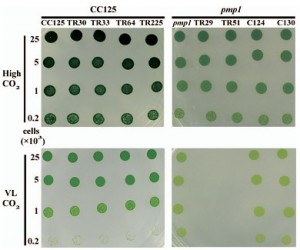Apr
13
A Major Algae Breakthrough for Fuels and Food
April 13, 2009 | 2 Comments
Martin Spalding, professor and chair of the Department of Genetics, Development and Cell Biology at Iowa State University has identified one of the key proteins in the algae responsible for concentrating and moving that CO2 into cells. “This is a real breakthrough. No one had previously identified any of the proteins that are involved in transporting CO2 in algae.”
I agree, knowing the protein goals is critical and a major improvement in what geneticists can seek and the direction to go in developing the algae strains to come. Additionally it sets a beginning trial marker for the most desirable algae strains. This is a very big breakthrough, indeed.
Global warming concerns duly noted and discounted by the hard facts, the lack of atmospheric carbon dioxide concentration actually limits the growth of plants and their aquatic relatives, algae. This applies across the plant kingdom for foods and the coming bio based fuel business. CO2 is vital to growth; it fuels the photosynthesis process that, along with sunlight, manufactures the basic sugars required for the totality of plant growth.
At this point in geologic time CO2 is present in such a limiting concentration that algae and some plants have evolved mechanisms to capture and concentrate CO2 in their cells to improve photosynthetic efficiency and increase growth. While the hysterics suggest that the planet is experiencing a dangerous and doomsday run up in CO2 concentration, the present day levels can be seen objectively as still quite low.
That makes the plants ability to concentrate CO2 into useful and efficient concentrations decidedly important. Spalding believes there are several possibilities to use the gene that encodes this protein. The recent gathering of interest in using algae for production of biofuels raises the possibility of increasing photosynthesis and productivity in algae.
It’s not just about fuels, major commodity crops such as rice, wheat and soybeans do not have any CO2 concentrating mechanism. Should the technology go to these resources a great deal of human health might be improved and hunger alleviated. Spaulding says, “One of the things we’ve been working on is the prospect that we may be able to take components of the CO2 concentrating mechanism for algae, such as this HLA3, and put it into something like rice and improve photosynthesis for rice.”
HLA3 is the protein Spaulding and Deqiang Duanmu, a graduate student in Spalding’s department; and Amy Miller, Kempton Horken and Donald Weeks; all from the University of Nebraska, Lincoln have isolated and researched. The work can be reviewed as published in the current issue of the journal Proceedings of the National Academy of Sciences of the United States of America.
Alone, the HLA3 in the microalgae that Spaulding group has identified is a breakthrough. Yet this might well be a first step. A thorough understanding, searches through the catalog of plant species, identifying other complementary proteins and other steps should bring astonishing improvements in food and fuel production.
I am concerned in a small way that this will not be seen in the significance it deserves. Many still think that biofuel sources are a dead end, even as raw sunlight to land area calculations show, using the most critical methods, that biofuels could displace a huge share of fossil energy use. Algae could and likely will see cost of production issues resolved and soon. With an apparent new low floor for crude oil in the mid $30s to mid $50s the sub one-dollar cost to refinery sale is the target.
Alga now has its protein for CO2 concentration IDed. If that alone is enough or other proteins or genetic factors are needed, they will surely show soon. What is certain is that the major midwestern universities are on their way to another food production revolution that one can expect to take the food vs. fuel issue off the table, at least until human population growth grows rapidly again.
One of the benefits to a century of fossil fuel use is that CO2 concentrations are a little higher. As some realize, the global warming hysteria carries with it dangerous risks – the reduction of CO2 concentration would have a negative effect in feeding the people of the world.
Thanks to science and the determined questioning and research as we can see at Iowa State, that risk is narrowed, as well as sourcing new paths to more abundant food and room for biofuels.
It’s rather a thrill or a relief. Its surely big news and congratulations are in order for the team.
Comments
2 Comments so far



Its a certainty I have no real education into your discovery but what I do understand is its implications. I suggest you check out Algaeventure Systems.They have perfected an efficient,simple,low cost,low energy system for extracting the water from algae. My understanding was that this was a big stumbling block to using algae in many applications. I don’t know if this is something that would be needed in your studies or not but felt it important enough to pass on.
Sincerely,
C. Bensing
My cousin recommended this blog and she was totally right keep up the fantastic work!